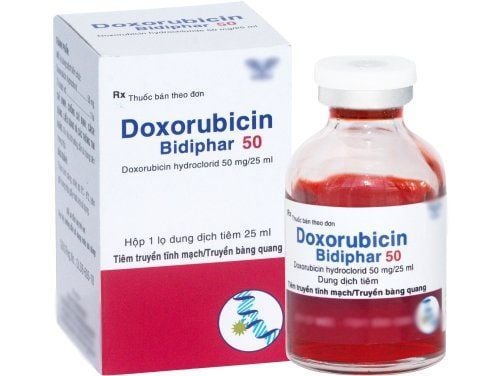This is an automatically translated article.
Paclitaxel is an anticancer drug. This active ingredient is in the medicine Paclitaxelium Actavis. So, how does the drug Paclitaxel Actavis work specifically?
1. What is Paclitaxelum Actavis?
Paclitaxelum Actavis contains the active ingredient Paclitaxel, manufactured by S.C. Sindan-Pharma (Romania).
Paclitaxelum Actavis is prepared as a concentrated solution for intravenous infusion, packed in each box of 1 vial of 5ml. Paclitaxel is an anti-cancer agent with the effect of modulating the immune response and suppressing cells.
2. What are the uses of Paclitaxelum Actavis?
Indications of Paclitaxelum Actavis:
Treatment of metastatic ovarian cancer when failure or contraindication to Anthracycline and Platin; Combined with Doxorubicin adjuvant therapy is considered the first line regimen in the treatment of metastatic breast cancer. Paclitaxelum Actavis is indicated when metastatic breast cancer fails to respond to anthracyclines or the cancer recurs within 6 months after adjuvant therapy; Treatment of non-small cell lung cancer or AIDS-related Kaposi's sarcoma. Contraindications of Paclitaxelum Actavis:
Hypersensitivity to Paclitaxel or to any of its ingredients, especially Cremophor EL oil because most patients will have a degree of hypersensitivity to Cremophor EL oil; Neutrophil count less than 1500/mm3 or obvious motor neuropathy; Pregnant or lactating patients; Paclitaxelum Actavis should not be used in children under 18 years of age because of the lack of safety and efficacy data.
3. Dosage of the drug Paclitaxelum Actavis
Patients should be prevented from symptoms of hypersensitivity to Paclitaxelum Actavis in the following ways:
Dexamethasone dose 20mg orally or intravenously 12 and 6 hours before the course of treatment; Intravenous Cimetidine 300mg or Ranitidine 50mg and Diphenhydramine 50mg about 30-60 minutes before the exam time. Dosage of Paclitaxelum Actavis to treat ovarian cancer:
First choice regimen: Combination of Cisplatin for the initial treatment of advanced ovarian cancer, there are 2 recommended regimens and patients choose according to their requirements of the patient. regimen 1: Paclitaxel 175 mg/m2 intravenous infusion 3 hours, then continue intravenous infusion of Cisplatin 75 mg/m2. Regimen 2: Paclitaxelum Actavis dose of 135mg/m2 intravenous infusion for 24 hours, then intravenous infusion of Cisplatin 75mg/m2, every 3 weeks; Second-line or next-line treatment for advanced ovarian cancer: Monotherapy at 135 or 175 mg/m2 IV over 3 hours and repeated every 3 weeks if tolerated. Breast cancer:
Paclitaxelum Actavis adjuvant treatment of breast cancer with lymph nodes: Paclitaxelum Actavis 175 mg/m2 IV infusion over 3 hours, every 3 weeks for a total of 4 courses, after completion continue to take Doxorubicin according to the regimen. coordination map; Second-line regimen for advanced breast cancer: For metastatic breast cancer that has been refractory to chemotherapy or for cancer that recurs within 6 months of adjuvant therapy. Use the usual Paclitaxelum Actavis 175 mg/m2 intravenously over 3 hours, every 3 weeks; Non-small cell lung cancer: When paclitaxelum actavis is combined with cisplatin for the initial treatment of non-small cell lung cancer in patients with no indication for surgery or radiotherapy, the recommended regimen is paclitaxelum actavis 135 mg/ m2 intravenous infusion over 24 hours, then intravenous infusion of Cisplatin 75mg/m2, every 3 weeks. Another regimen is Paclitaxelum Actavis 175 mg/m2 intravenously over 3 hours, then Cisplatin 80 mg/m2, every 3 weeks;
AIDS-associated Kaposi's sarcoma
Patients with advanced HIV infection should only be started on Paclitaxelum Actavis if the neutrophil count is at least 1000/mm3; For patients with AIDS-related Kaposi's sarcoma who have not responded to first-line or next-line chemotherapy, two regimens with paclitaxel are recommended as the first regimen infusion of paclitaxel at 135 mg/m2 in 3 hours, every 3 weeks. Regimen 2 is to use Paclitaxelum Actavis 100 mg/m2 intravenously over 3 hours, every 2 weeks. The dose limit of Paclitaxelum Actavis may be reduced in patients with hepatic impairment.
In patients with a severely reduced granulocyte count (less than 500/mm3) during long-term treatment with Paclitaxelum Actavis, it is best to reduce the daily dose by 20%. A repeat course of Paclitaxelum Actavis is obtained when the granulocyte count is above 1,500 cells/mm3 and the platelet count is above 100,000 cells/mm3. In HIV-infected patients, the cycle of Paclitaxelum Actavis should only be repeated when the granulocyte count is at least 1,000/mm3.
4. How to take Paclitaxelium Actavis
Intravenous administration of Paclitaxelum Actavis should be carried out by an experienced person in an appropriate laboratory. When mixing the drug, it is necessary to wear gloves and proceed with caution to avoid contact with the skin and mucous membranes. If the skin is in contact with the drug, it must be washed thoroughly with soap and water. In case of mucosal burns, rinse thoroughly with water. The process of mixing Paclitaxelum Actavis must ensure sterility. Solvent for dilution of Paclitaxelum Actavis can be Sodium chloride 0.9%, Glucose 5%, a mixture of 0.9% Sodium chloride and Glucose 5% or a mixture of 5% Glucose solution and lactate ringer. Paclitaxelum Actavis should only be stored in sealed vials or bottles made of glass, polypropylene or polyolefin. The infusion of Paclitaxelum Actavis after preparation can maintain physico-chemical stability for 27 hours at room temperature (about 25 degrees Celsius) and under light. During preparation, the Paclitaxelum Actavis infusion solution may become slightly cloudy.
5. Side effects of Paclitaxelum Actavis
Spinal cord dysfunction; Lower blood pressure; Increase liver enzymes ; Muscle pain, joint pain; Digestive disorders ; Hair loss; Peripheral neuropathy.
6. Precautions when using Paclitaxelium Actavis
Paclitaxelum Actavis dose should be reduced in patients with liver dysfunction or impaired liver function. Paclitaxel is not recommended for use in cases where liver enzymes are increased 10 times the upper limit of normal or bilirubin is more than 7.5 mg/100 ml or more than 5 times the upper limit of normal.
Use Paclitaxelum Actavis with caution in patients with cardiovascular disease.
In the preparation Paclitaxelum Actavis, the excipient is cremophor EL. This substance is more likely to induce anaphylactoid responses by stimulating the release of more histamine in hypersensitivity patients. Therefore, physicians should prescribe anaphylaxis prophylactic agents prior to treatment with Paclitaxelum Actavis and must be prepared for countermeasures for anaphylactic reactions.
Paclitaxelum Actavis should be used with caution in patients with a history of peripheral neuropathy (due to chemotherapy or diabetes).
When multiple drugs are administered sequentially, taxane derivatives (eg, Paclitaxelum Actavis or Docetaxel) should be administered before platinum derivatives to reduce the risk of myelosuppression.
Older adults are more likely to have an increased risk of toxicity, including neuropathy or agranulocytosis.
Please dial HOTLINE for more information or register for an appointment HERE. Download MyVinmec app to make appointments faster and to manage your bookings easily.













